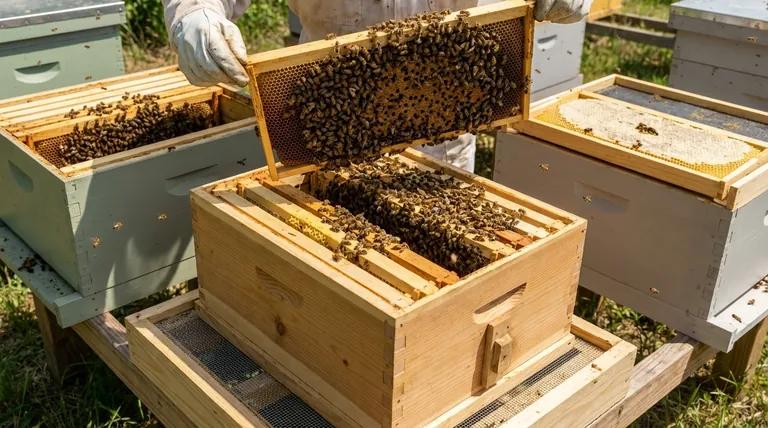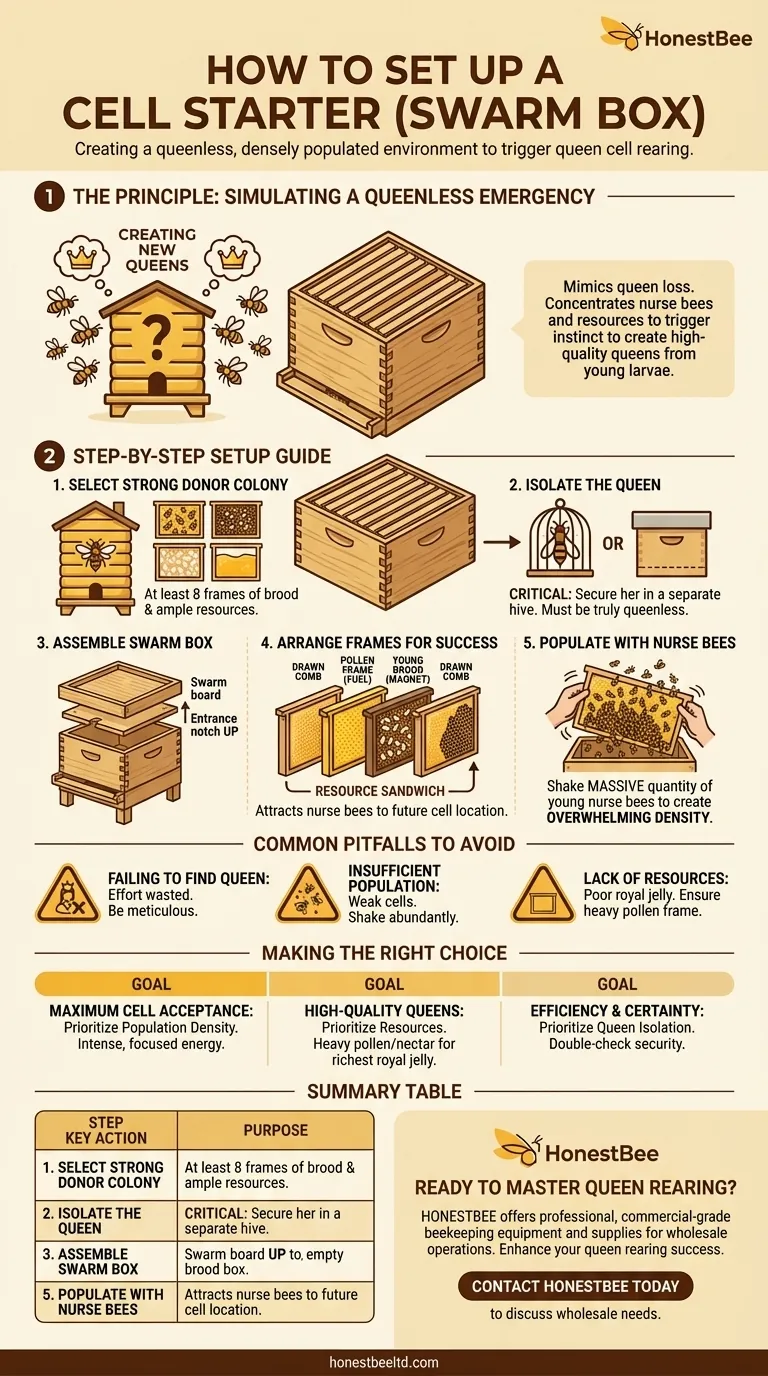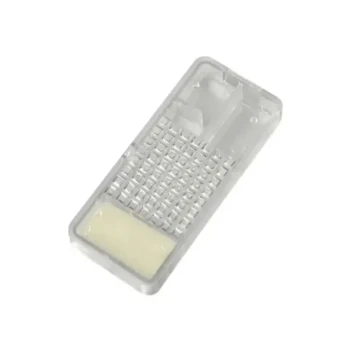To properly set up a cell starter or swarm box, you must create a densely populated, queenless environment that simulates an emergency. This involves arranging specific frames—drawn comb, pollen, and young brood—in a brood box and then shaking in a massive quantity of young nurse bees from a strong, healthy colony after ensuring the queen has been safely isolated.
The entire purpose of a swarm box is to mimic the sudden loss of a queen. By concentrating a large population of nurse bees with all necessary resources but no queen, you trigger their instinct to create new queens from the young larvae you will provide.

The Principle: Simulating a Queenless Emergency
A honey bee colony is driven by the presence of queen pheromones. When a queen is lost, these pheromones disappear, signaling an emergency. The worker bees—specifically the younger "nurse" bees—are biologically compelled to create a new queen.
A cell starter artificially creates this state of emergency in a controlled way. By removing the queen and concentrating the resources, you can direct this powerful impulse toward raising high-quality queens from your selected genetics.
Step 1: Select a Powerful "Donor" Colony
Your success begins with the colony you choose. It must be strong and healthy.
Look for a colony that has at least eight frames of brood in various stages. It should also be "honey-bound" or have significant stores of pollen and nectar, which indicates a robust and well-fed population.
Step 2: Isolate the Queen
This is the most critical step. You absolutely must find and secure the queen from the donor colony.
Place her on a frame of brood with adhering bees in a separate box and set her aside. If she ends up in the swarm box, the bees will not feel queenless and will not start any cells.
Step 3: Assemble the Swarm Box Components
The physical setup is simple but must be done correctly.
Place your swarm board on a hive stand. Ensure the entrance notch is facing up to provide ventilation. Then, place an empty brood box directly on top of the swarm board.
Step 4: Arrange the Frames for Success
The order and type of frames you place inside the box are designed to attract and support the nurse bees.
Arrange four frames in this specific order:
- Drawn Comb: This provides space and structure on one side.
- Pollen Frame: This is the fuel. Nurse bees consume pollen to produce the royal jelly needed to feed queen larvae.
- Frame of Young Brood: This frame is a magnet for nurse bees. The pheromones from young larvae attract them to this area.
- Drawn Comb: This encloses the cluster on the other side.
This arrangement creates a "resource sandwich" that concentrates the nurse bees exactly where you will eventually place your grafted queen cells.
Step 5: Populate with Nurse Bees
The final step is to create an overwhelming population density.
Go back to the brood frames of your donor colony. Identify frames heavy with young, open larvae, as these are covered in nurse bees. Shake these bees directly into the swarm box until they completely cover all the frames, often forming a thick, hanging cluster.
Common Pitfalls to Avoid
Creating the perfect queenless environment requires avoiding a few key mistakes that can lead to complete failure.
Failing to Find the Queen
If even one queen is present, the entire effort is wasted. Be meticulous in finding and isolating her before you begin shaking bees.
Insufficient Nurse Bee Population
A sparse population will not generate the heat or have the capacity to feed queen cells properly. The goal is to have so many bees that they are overflowing. Do not be timid when shaking bees into the box.
Forgetting Key Resources
A lack of pollen is a primary reason for failure. Without this protein source, nurse bees cannot produce the high-quality royal jelly needed to raise robust queens. Ensure the pollen frame is heavy and accessible.
Making the Right Choice for Your Goal
Your primary objective is to create an environment so compelling that the bees have no choice but to build excellent queen cells.
- If your primary focus is maximum cell acceptance: Prioritize population density above all else. A crowded swarm box creates the intense, focused energy needed to start a large number of cells.
- If your primary focus is high-quality queens: Prioritize resources. A heavy frame of pollen and nectar ensures the nurse bees are well-fed and can produce the richest royal jelly for the developing larvae.
- If your primary focus is efficiency and certainty: Prioritize the queen's isolation. Double-check that she is secure before you do anything else to avoid wasting time and effort on a setup that is not truly queenless.
Ultimately, a successful cell starter is a carefully constructed system designed to channel the bees' powerful natural instincts toward your goal.
Summary Table:
| Step | Key Action | Purpose |
|---|---|---|
| 1 | Select a strong donor colony | Provides robust nurse bees and resources |
| 2 | Isolate the queen | Creates a true queenless emergency state |
| 3 | Assemble swarm box with entrance up | Ensures proper ventilation and bee access |
| 4 | Arrange frames: comb-pollen-brood-comb | Creates resource sandwich for nurse bees |
| 5 | Shake in abundant nurse bees | Creates dense population for cell feeding |
Ready to Master Queen Rearing?
Whether you're a commercial apiary looking to scale your queen production or a beekeeping equipment distributor seeking reliable supplies, HONESTBEE has the solutions you need. Our wholesale-focused operations provide commercial-grade beekeeping equipment and supplies designed for professional beekeepers.
We understand that successful queen rearing requires precision equipment and reliable resources. From swarm boxes to specialized frames, our products are built to support your commercial beekeeping operations.
Contact HONESTBEE today to discuss your wholesale beekeeping supply needs and learn how our equipment can help you achieve consistent queen rearing success.
Visual Guide

Related Products
- No Grafting Queen Rearing Kit: System for Royal Jelly Production and Queen Rearing
- Nicot Queen Rearing Kit for Beekeeping and Grafting in Nicot System
- Portable Bee Mating Hive Boxes Mini Mating Nucs 8 Frames for Queen Rearing
- Brown Nicot Queen Cell Cups for Breeding Queen Bees Beekeeping
- Twin Queen Styrofoam Honey Bee Nucs Mating and Breeding Box
People Also Ask
- What is the timeline for queen breeding? A 28-Day Guide from Egg to Laying Queen
- What steps should be taken if a queen is lost? Save Your Queenless Hive Now
- What is requeening, and why is it performed? Take Control of Your Hive's Health and Productivity
- What are the developmental periods for different bee castes? Master the 16, 21, and 24-Day Timelines for Hive Success
- How can beekeepers start a honey bee breeding program? Build a Superior, Resilient Apiary



















